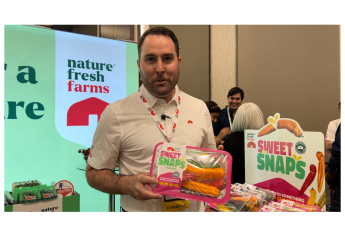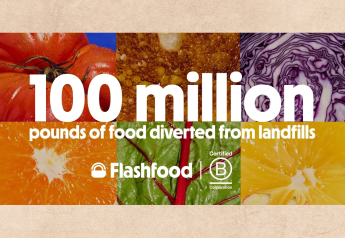UPDATED: Container rates slip but conditions remain challenging for exporters

UPDATED: A recent substantial decline in ocean container rates from Asia to the U.S. may give U.S. fresh produce exporters a slightly better chance at finding slots to ship to Asia and other markets.
Still, industry leaders say the ocean container crisis will take much longer to normalize.
Container shipping rates from China to the East Coast topped $20,000 per 40-pound unit in August, up from $11,000 in July and five times the $4,000 rate of a year ago, according to the freight tracking firm Freightos.com.
However, data provided by digital freight forwarding company Shifl shows that the spot rate for shipping a 40-foot container from China to Los Angeles dropped by $9,000, or 51.4%, between September and early October of this year. Spot rates dropped from $17,500 in September to $8,500 in early October, Shifl reported.
The decline was likely tied to cutbacks in energy supplied to China’s factories, resulting less production and less demand for containers to export goods, said Shabsie Levy, founder and CEO of New York-based freight forwarder Shifl.
“The question is, what is (the rate) going to be in a month from now, or two months, three months?” Levy said.
“Who knows? I highly doubt we’re going to see $20,000 again; I think this is somewhat of a trajectory towards stabilization and eventually getting back into normalization in the industry.”
The strong demand for containers in Asia to ship goods has resulted in many containers arriving in the U.S. and then being immediately sent back to China empty, Levy said. That left availability of containers extremely limited for U.S. exporters, including fresh produce exporters, despite relatively cheap containers rates from the U.S. to Asia.
The U.S. Department of Agriculture reported 40-foot container rates from Los Angeles to China averaged $1,630 in August, up from $1,520 per container in June.
Andrew Brown, export sales and account manager at Delano, Calif.-based Pandol Bros. said in an e-mail that the tight container situation is related to equipment availability, lack of vessel options, lack of trucking options and inefficient, outdated ports. Consolidation of steamship lines also has made the bottlenecks worse.
“The priority has been very clear that empties going back to Asia are over anything else,” Brown said in the e-mail. “Steamships are not making outbound exports a priority at all.”
Levy said that carriers had a tremendous shortage of containers out of Asia and so it didn’t make sense for the carriers to release containers for the additional week for the exporters to load them because they would lose a week for a very minimal price.
“The issue a lot of exporters were struggling with was not a demand issue, it was just a rush (by) the carriers to get that empty container back right to China to get other goods out,” Levy said.
Lower rates from China should eventually allow better container availability for U.S. exporters, he said.
“If containers are not in as big of a crunch, and pricing drops, then it makes sense for the carriers again to send those containers out to the exporters to fill them up,” he said.
Still, there are big logistical issues for ocean-going freight. In Southern California, there were about 70 ships waiting to be unloaded in early October, Levy said.
Delays in unloading at Los Angeles and Long Beach have sent many importers looking at West Coast alternatives such as Seattle and Vancouver, but Freightos.com reports those shifts in cargo destinations are causing congestion in those ports.
Data from Freightos.com also shows that last month, China-to-U.S. ocean shipments took an average of 73 days to arrive at their final destination, 83% longer than in September 2019.
The shipping disruptions are causing some major retailers like Home Depot and Costco to charter their own container ships to secure some ocean space, and Freightos.com said Coca-Cola has announced it recently moved a 60,000-ton shipment in sacks aboard a bulk carrier instead of in containers.
Levy said the container market will stabilize but it is hard to predict when that will happen.
Consumers will eventually turn their attention from buying imported goods to spending money on traveling and eating out, he said. That should ease the container market.
Apple exporters are able to find some containers for export shipments to Asian markets but not all they need, said Mark Powers, president of the Yakima, Wash.-based Northwest Horticultural Council.
In the 12-month period from September 2020 to August 2021, U.S. fresh fruit exports to East Asia markets declined in volume by 4% compared with the previous year. U.S. fresh fruit exports to Southeast Asia declined 26% in volume in the same period, according to USDA trade numbers.
“The only positive I would kind of throw out there is that we sell an awful lot of apples to Canada and Mexico, and those don’t have to go on a boat,” Powers said.
The council and other groups are lobbying the government to ease the logistical challenges for exporters. “That doesn’t help our guys in the short term, when they’re not able to get the ocean containers they need.”
Powers said he thinks the tight container market is likely to persist through much of the 2021-22 marketing season.
White House
In an Oct. 13 speech, President Biden announced the ports of Los Angeles and Long Beach, which handle 40% of container volume coming into the U.S., have now both agreed to extend their hours to deal with the bottlenecks.
“After weeks of negotiation and working with my team and with the major union and retailers and freight movers, the Port of Los Angeles announced today that it’s going to begin operating 24 hours a day, 7 days a week,” Biden said in his address. The Port of Long Beach announced its commitment to 24/7 operations a few weeks ago.
“This is the first key step toward moving our entire freight transportation and logistical supply chain, nationwide, to a 24/7 system,” Biden said.
Traditionally, Biden said that U.S. ports have only been open from Monday through Friday, with operations closed on nights and weekends.
By staying open seven days a week, through the night and on the weekends, the Port of Los Angeles will have more than 60 extra hours per week to operate, nearly doubling the hours the port is open compared with earlier this year.
“And more than that, the night hours are critical for increasing the movement of goods because highways — highways are less crowded at night,” Biden said.
Biden said that Walmart, the biggest U.S. retailer, has committed to moving product 24/7 from ports to its distribution centers.
“Specifically, Walmart is committing as much as a 50% increase in the use of off-peak hours over the next several weeks, Biden said in his address.
FedEx and UPS, freight movers that account for up to 40% of packages delivered in America, will also move to 24/7 operation, Biden said.
Biden also said his infrastructure bill now being considered by Congress will invest billions in port, highways and rail systems.
“We’ve seen the cost of inaction in the pandemic in the delays and the congestion that affect every American,” he said in his address. “But it’s fully within our capacity to act to make sure it never happens again — it’s going to take a little time — and that we unlock the full might and dynamism of our economy and our people.”







